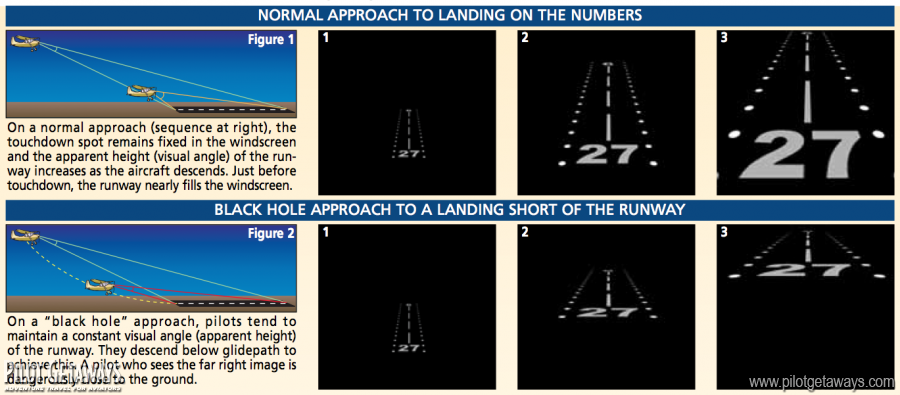...In fact, I flew in there myself! During part of my training back in January, I had to complete a night 'cross-country' flight (greater than 100 miles round trip) with my instructor. We also had to make the flight about 2.2 hours in length in order to fulfill my time requirement as well. The flight was planned from Clow Airport, Bolingbrook, IL (1C5) to Starke County Airport, Knox, IN (OXI). Along our route, there were winds that pushed us there at about 150 MPH - about 40 MPH faster than usual. As a result, we got there earlier than normal.
While at OXI, we performed a 3-4 takeoffs and landings, again to meet the requirements for training. Something pretty interesting that I got to experience at OXI was the "Black Hole Effect." Around the airport, there is nothing but farmland, and at night, the only lights for a mile or so around are the relatively bright runway and approach lights. As you can see below, a Black Hole approach could result in landing below the glidepath and possibly crashing, which thankfully didn't happen in my case. Definitely glad that I got to experience this phenomena with an instructor before experiencing it myself.
On the way back to 1C5, those same winds that gave us a 40 MPH boost on the way there were slowing us down by 40 MPH on the way back. While on the way back, my instructor and I calculated our estimated time of arrival back to 1C5, which would put me short of the hours that I needed to complete my night training. It was then that we decided to have a little fun and see if we could stop at MDW on our way back. Even though it would be a small detour, it would not only be a lot of fun, but give us the sufficient amount of hours as well.
En route to MDW, we needed to tune the radio to the ATIS, or Automated Terminal Information System - basically a robotic voice that played the current weather and different runways in use, After that, when approximately 15 miles away from the airport, I called up the control tower. When calling, I had to state the registration number of my aircraft (N72662), the aircraft type (Cessna 172), our location and altitude (15 miles SE, 3000 ft), the current weather information that we had (information India), and our intentions (the option to either land or perform a touch-and-go). From there, he told me to stay at or below 2000 ft and assigned me what's called a squawk. A squawk is a 4 number code that we have to enter into our transponder on the plane so that we are visible to the controller on his radar.
As we continued on our way, getting lower and lower over the city, we were able to see all of the Southwest jets and other private jets taking off and seemingly heading straight for us before climbing up thousands of feet above us. As we got within about 5 miles of MDW, the controller told us to follow the approach path to fly straight over the airport at 1,500 ft. My instructor and I were excited to say the least, because we would be given a view of the airport that you don't regularly get. It was also when we got within 5 miles that the air began to get pretty turbulent. We were low enough where the winds that were deflecting off of the houses and buildings right below us were buffeting our plane around a decent, but very manageable, amount.
Believe it or not, it was incredibly hard to spot the airport from a couple miles out - I was actually very surprised...not sure how commercial pilots do it on a daily (or nightly??) basis. Personally, I blame the orange street lights used by the City of Chicago, but that's a rant for another day...
 |
| Picture of the gate concourse area at MDW taken by my instructor. The two bright white lights above the two green lines are the wings of a taxiing Southwest 737 |
Night flying, especially night flying into a busy commercial airport like MDW, is definitely something special, and something that can provide incredible views that not many other people get to experience. I can't wait until the day that I'm fully licensed so I can take my family and friends around at night, and hopefully into MDW and along the Chicago shoreline! I'd love to take any of you...
 |
| Route of the Above Flight |
Hope you all enjoyed this post! Next week (3/21 - 3/28), I plan on (weather permitting) finishing my license while I'm on my spring break. More to come in the following days on the progress of that!
Happy flying!

No comments:
Post a Comment